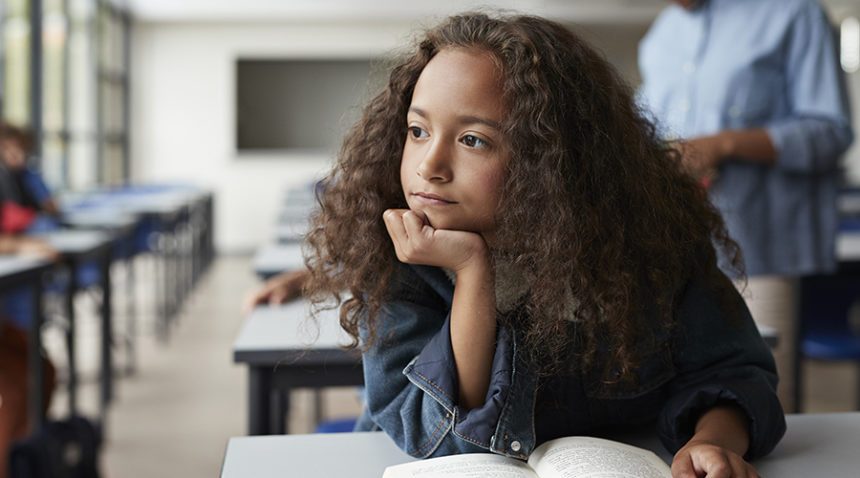After two years of wearing masks in public, taking classes online, being in lockdown, and seeing friends and family only over a screen, the COVID-19 pandemic has left its mark on children and teens.
But are the changes permanent—and are they all bad?
We spoke with UNC Health pediatrician Rebecca Baum, MD, who specializes in development and behavior in children, to find out more about what we can expect. The bottom line: We’re not sure yet.
“We all have to remember that we’ve had a significant interruption in our routines,” she says. “For many people, ‘going back to normal’ doesn’t mean going back to exactly what life was like before the pandemic.”
Anxiety and Depression on the Rise in Kids
Dr. Baum says she is seeing an increasing number of children who are feeling anxious or depressed. In fact, studies show that cases of depression and anxiety in children and adolescents doubled during the first year of the pandemic. Many are grieving the death of loved ones in addition to experiencing loneliness and loss.
“We were already struggling to provide enough mental health support, especially for children, before COVID,” Dr. Baum says. “The increased cases are really taxing an already overstressed system.”
Effects on Older Children and Teens
Many older children and teens struggled during online learning.
“I’ve had many patients tell me that academic expectations were low at the start of the pandemic when schools were suddenly transitioning to online learning,” Dr. Baum says. “Now that they are back in the classroom, they are having a hard time regaining their motivation to do the work.”
Other studies confirm what teachers are saying: Many children are behind in their learning levels compared with students in years past. Testing scores seem to show that math learning has suffered more than language arts.
Other aspects of daily life have been hard, too. During adolescence and the teen years, children are discovering who they are.
“That’s when you’re trying to forge your identity,” Dr. Baum says. “That’s hard enough to do during normal times, but it’s been incredibly hard for some teens during the pandemic.”
Kids have missed out on major milestones, such as high school graduation or starting middle school.
“Those pieces that mark the transition from one phase to another have looked really different,” Dr. Baum says. “And trying to make new connections in an online era can be hard. Thankfully, older children and teens also represent some of the most tech-savvy groups in our population, which is likely an advantage in this case.”
Effects on Young Children
While older children and teens may have suffered from less time with peers, young children may have had a different experience, Dr. Baum says. Many young children may have spent more time with parents or caregivers during the pandemic. Those interactions with loved ones are important for supporting social-emotional development.
Many people have asked about the effect of mask-wearing on young children.
“While some facial expressions may be more difficult to read with mask-wearing, the good news is that unmasked encounters with loved ones typically still have occurred,” Dr. Baum says.
Barriers for the Most Vulnerable
Support that many children and teens depend on at school has been paused during the pandemic. Special learning services, counseling, English as a second language classes and other supportive programs haven’t always been available. And without in-person school days, many schools and community groups worked hard to provide meals for children who depend on schools for access to nutritious food.
“Children who need services like these are the most vulnerable,” Dr. Baum says.
Online learning also posed obstacles for many students. Children whose parents could not help them with their studies at home were more likely to fall behind than those who had their parents’ assistance. Children who didn’t have access to reliable internet service and computers or other devices had more difficulty learning remotely as well.
“Significant disparities were highlighted during the pandemic,” Dr. Baum says.
Pros and Cons of Screen Time
Nearly all children had significantly more screen time than they did before the pandemic, she says, which was both good and bad.
“For many kids, it can be difficult to engage with online learning,” Dr. Baum says. “Excess screen time can also take away from time with family, friends, and time spent outdoors.”
On the other hand, being able to connect with friends and relatives virtually was helpful for a lot of children. Many families also found that they had more time to spend together than they did before COVID-19 arrived.
What Can Parents Do?
“First and foremost, parents can listen to the children and try to understand what they’re feeling,” Dr. Baum says. “The hardest thing most of us have faced in the pandemic is uncertainty. If parents can build in as much routine and structure as they can, then their children will feel more secure.”
Be aware of signs that your child is not doing well, and help your child put things in perspective.
“Remember this has been a hard time for everyone, but how each of us have experienced the pandemic is different,” Dr. Baum says. “That’s where listening and understanding really comes into play.”
If you are concerned about how your child is doing, talk to their doctor, or find one near you.

